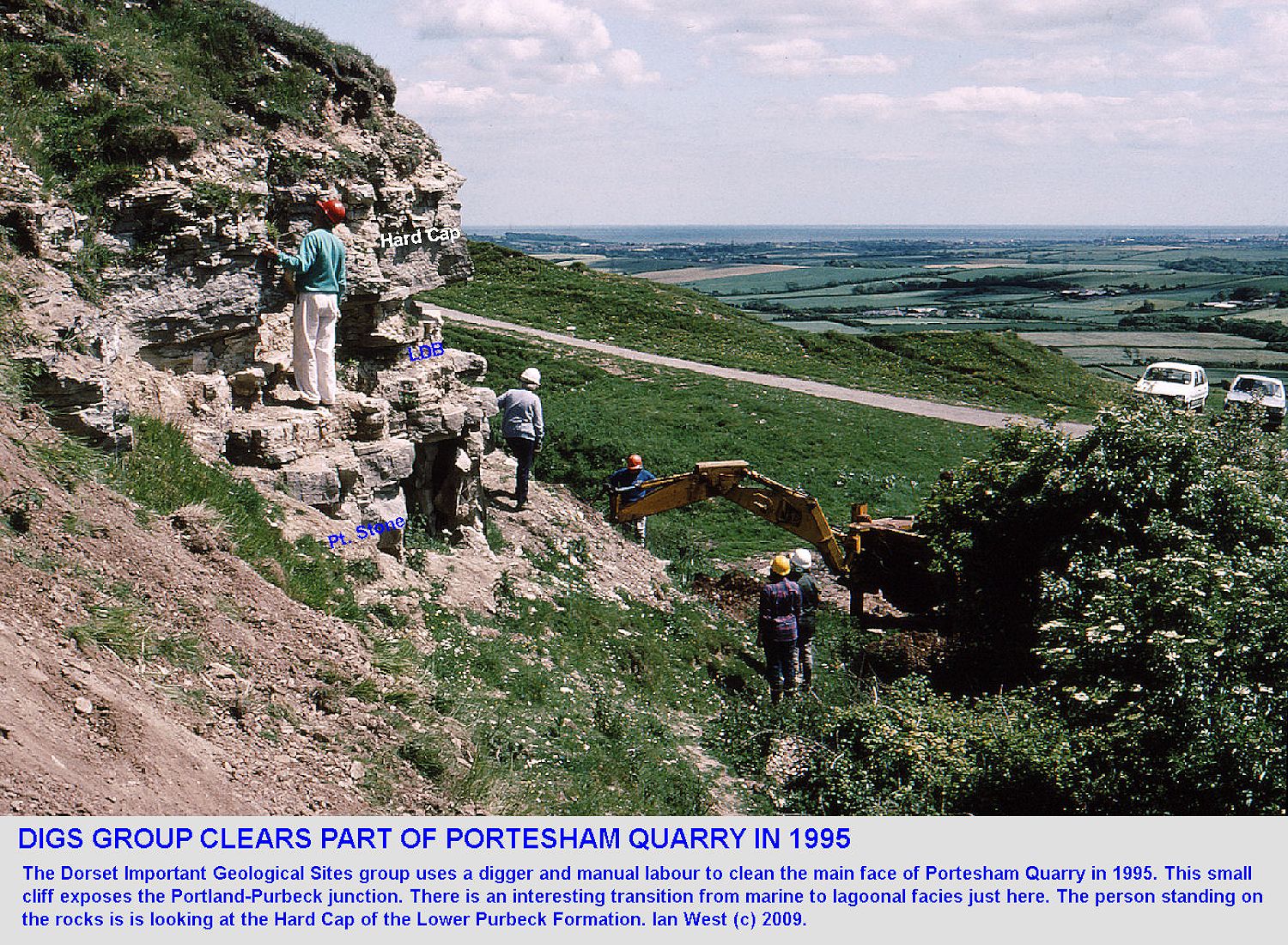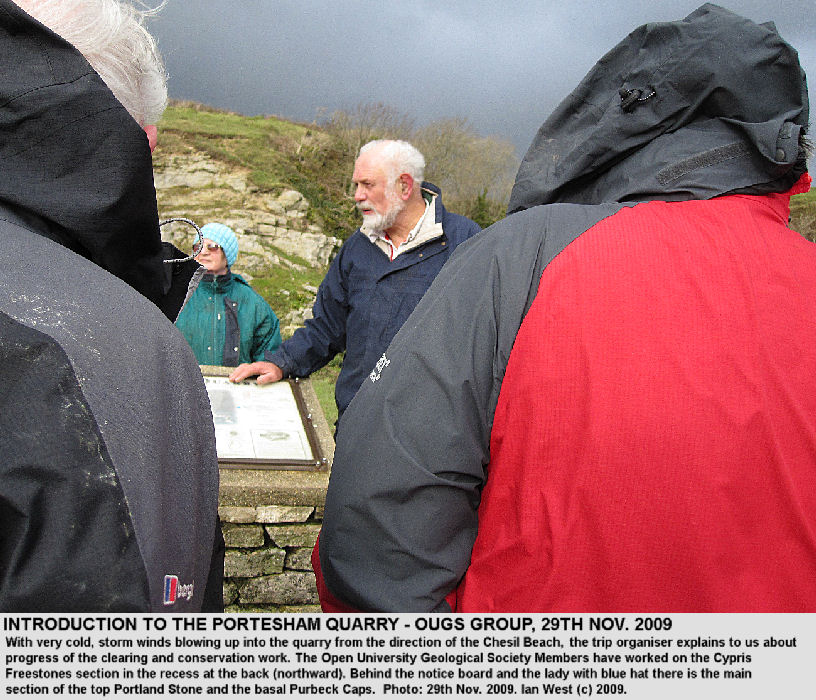
The type-section of the Purbeck Formation is at Durlston Bay (see also other Durlston Bay webpages). The key work on this is the detailed log by Roy Clements (1993), which should be consulted for information on lithology and faunal content of indivual beds. At Portesham only the lowest part of the Purbeck sequence is visible. At present the top of the Portland Stone, the Purbeck Caps and marl which is equivalent to the Great Dirt Bed can be seen together with a section of the 'Cypris' Freestones at the back of the quarry.
More could be seen in the past. Woodward (1893) gave the following thicknesses, in downward sequence:
Soft Cockle Member - 5 ft. (1.52 m.) (it is uncertain whether this is the total of the SCM or just what was seen).
Hard Cockle Member - 5 ft., 9 inches, (1.75 m.)
Lower Insect Beds - 4 ft. (1.2 m.)
'Cypris' Freestones - 22 ft. 11 inches (7 m.) to 23 ft. 11 inches (7.28 m.)
Strata equivalent to the Broken Beds and the Hard and
Soft Cap (details shown in a log given here) - 23 ft. 10 inches (7.28 m) to 25 ft. 4 inches (7.7 m.)
(I measured (in about 1960) approximately 6.35 metres for this basal part of the sequence, but the measurements will vary slightly from place to place within the quarry, and accuracy will depend upon state of exposure. I cannot be sure that I placed the junction of the Cypris Freestones with the BB equivalent accurately because of the poor state of the exposure. Thus Woodward's measurements are probably better).

The Purbeck Formation consists of limestones, shales and marls of lagoonal and lacustrine origin. There some relatively thin parts, such as the Cinder Bed or Cinder Member, which were deposited in marine salinity. Most of the formation, however, originated in very variable salinity conditions and ammonites are absent. Thus the zoning on marine fossils is not useful in the Dorset area. Instead ostracods ["water fleas"] are used because the minute shell so these are common in the Purbeck Formation. In parts, as in the "Cypris" Freestones they are actually rock-forming. Zonal schemes based on ostracods have been clearly shown in a diagram of Horne (2002) and which includes his 1995 scheme. A modified version of this is provided above.
Note that the scheme is based on species of Cypridea, the freshwater (or low salinity) ostracod. This has a distinctive beak and a variable pattern of turbercles or surface ornament. Because substantial parts of the Middle Purbeck and Upper Purbeck are "freshwater" ostracods of this genus are easily found there. The Lower Purbeck is more problematical because it is largely of hypersaline origin and contains much gypsum and replaced gypsum and some replaced halite. It is so evaporitic that it is a commercial source of gypsum for plaster in mines and Sussex, and formerly on the Dorset coast. In boreholes anhydrite is commonly found in the lower part. The hypersaline Lower Purbeck Formation does not often contain freshwater strata. Portesham Rocket Quarry and the Ridgeway Railway cutting are the main localities for low salinity Lower Purbecks. Even then it is only certain beds, mainly the equivalent of the Great Dirt Bed, which contains a freshwater fauna. Thus the field evidence for Cypridea dunkeri is limited. Portesham Quarry is probably the only place in Dorset where you can easily find this fossil. Further inland, however, there is an unusual Purbeck facies at Swindon which contain abundant Cypridea dunkeri. This will be discussed in a separate section below.

INTRODUCTION
Sedimentological and Faunal Logs of the Basal Purbeck Strata






Portesham Rocket Quarry(National Grid map reference SY 611857)is the most westerly exposure of the basal Purbeck Formation. At the base of the section there is a gradual transition over a few centimetres between typical Portland and Purbeck facies. Between the junction and the Lower Dirt Bed (Beds 8-10) no evaporites are present and laminated limestones with ostracods and other fauna occur. Above this dirt bed are remains of trees which were probably once rooted in it. A large sheath of thrombolitic stromatoltie which formerly coated one such tree was described by Woodward (1895) and can still be seen in the quarry. Woodward regarded this as "tufa" because stromatolites were not understood at that date. The notable stromatolite is discussed further below.
At the base of some marls (bed 19), probably corresponding to the Great Dirt Bed, unusual chert nodules occur. Within these, perfect lutecite pseudomorphs after lenticular crystals of gypsum even contain traces of the original (010) cleavage. Also present within this chert are silicilied remains of charophytes, freshwater ostracods, gastropods and land plants (Barker et al., 1975). Affinities were suggested (West, 1961) between the fauna and flora of the charophyte chert and problematical Purbeck strata at Swindon as described by Sylvester Bradley (1941). The marls associated with this chert contain similar freshwater fossils and other bands of evaporitic chert.
Gypsum replaced by calcite and chert is common in beds 21 to 23 and 26 to 31. Bed 28 and the lower part of bed 30 contain black intraclasts.
The major facies, described above, can be recognised in the Portesham section. Their limits are shown in Fig. 5. Within these broad facies, the effects of smaller variations in depositional conditions can be observed in terms of replaced evaporites and of skeletal debris. Six microfacies are listed below. The main characteristics of each appears to have resulted from particular palaeosalinity conditions. Their occurrence in the vertical section is shown-in Fig. 5. Obviously, many minor fluctuations in palaeosalinity will remain undetected.
I. Carbonaceous soils and associated marls containing freshwater fossils. Subaerial or freshwater conditions are indicated.
2. Limestones with marine faunas including cephalopods, sponge spicules, thick-shelled bivalves and occasional echinoderm remains. Comparison with modern environments (Hughes Clarke and Keij, 1973; Logan and Cebulski, 1970) suggests origins in water of less than 50 parts per thousand.
3. Limestones with foraminifera, ostracods and sometimes calcispheres. Usual marine macrofossils and bioturbation are absent. Facies A is mainly composed of such beds and discussion above suggests that they probably originated in palaeosalinities between about 50 and 70 parts per thousand.
4. Limestones either without fossils or with only ostracods. Discussion above indicates that such beds, of which facies D here consists, originated in palaeosalinities between about 70 and 124 parts per thousand.

STRATIGRAPHY OF BASAL PURBECK STRATA:
Transition Bed to Hard Cap
.


STRATIGRAPHY OF BASAL PURBECK STRATA:
Hard Cap - Details
.

The Hard Cap at Portesham Rocket Quarry has three major parts, of which the middle is the hardest and the most projecting in a weathered section. All parts are of peletoidal limestone of hypersaline origin. Small nodules of chert are present at certain horizons. These are early replacements of lenticular gypsum, prior to the usual sulphate diagenesis. This early silicification is compatible with the early silicification of coniferous tree stumps. The trees are coated in thrombolitic limestone in the lowest of the three beds and immediately above the Lower Dirt Bed.

STRATIGRAPHY:
Portesham Charophyte Chert and Associated Marl
(Bed 19 on Section Log).
.
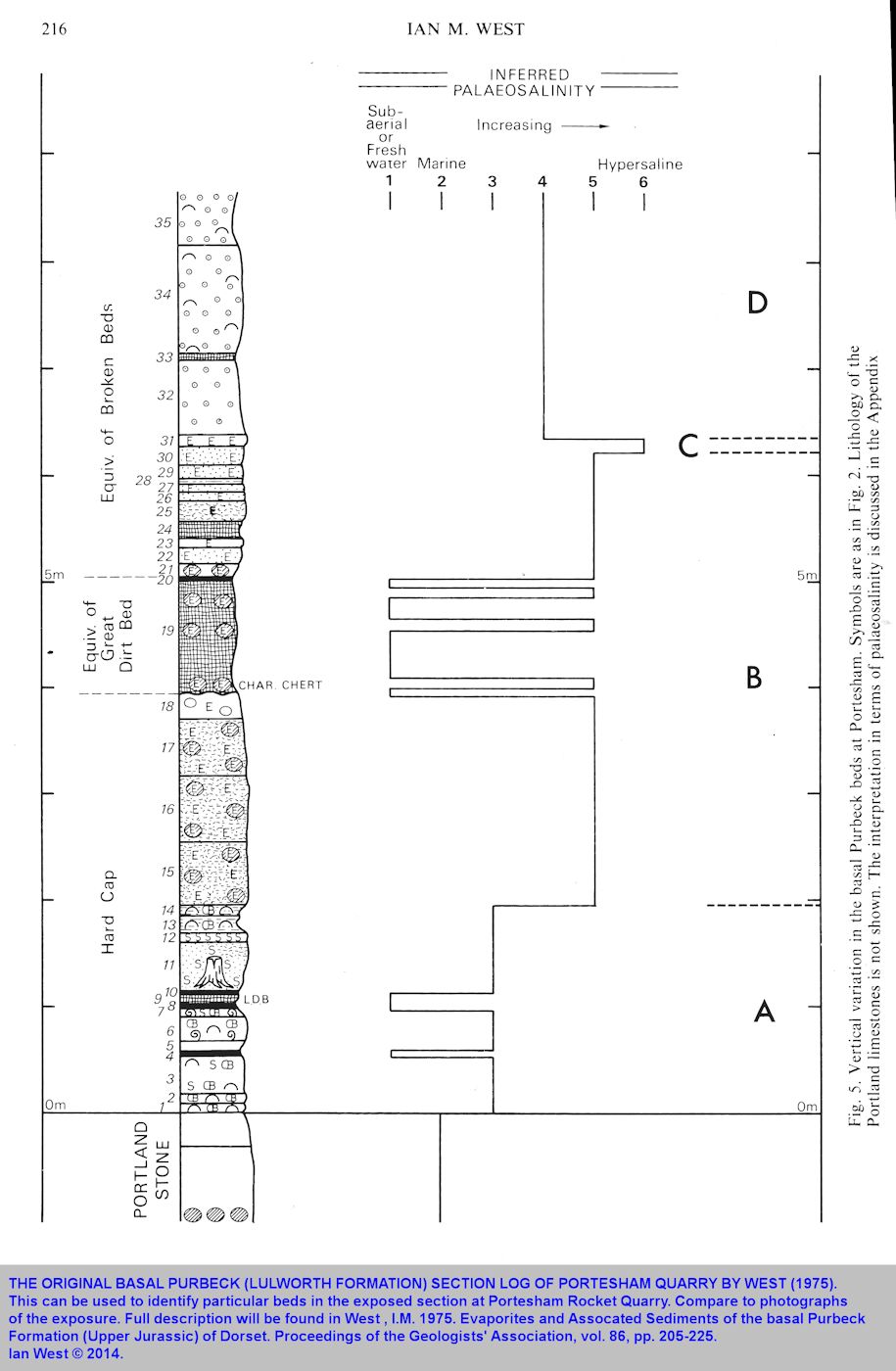
.
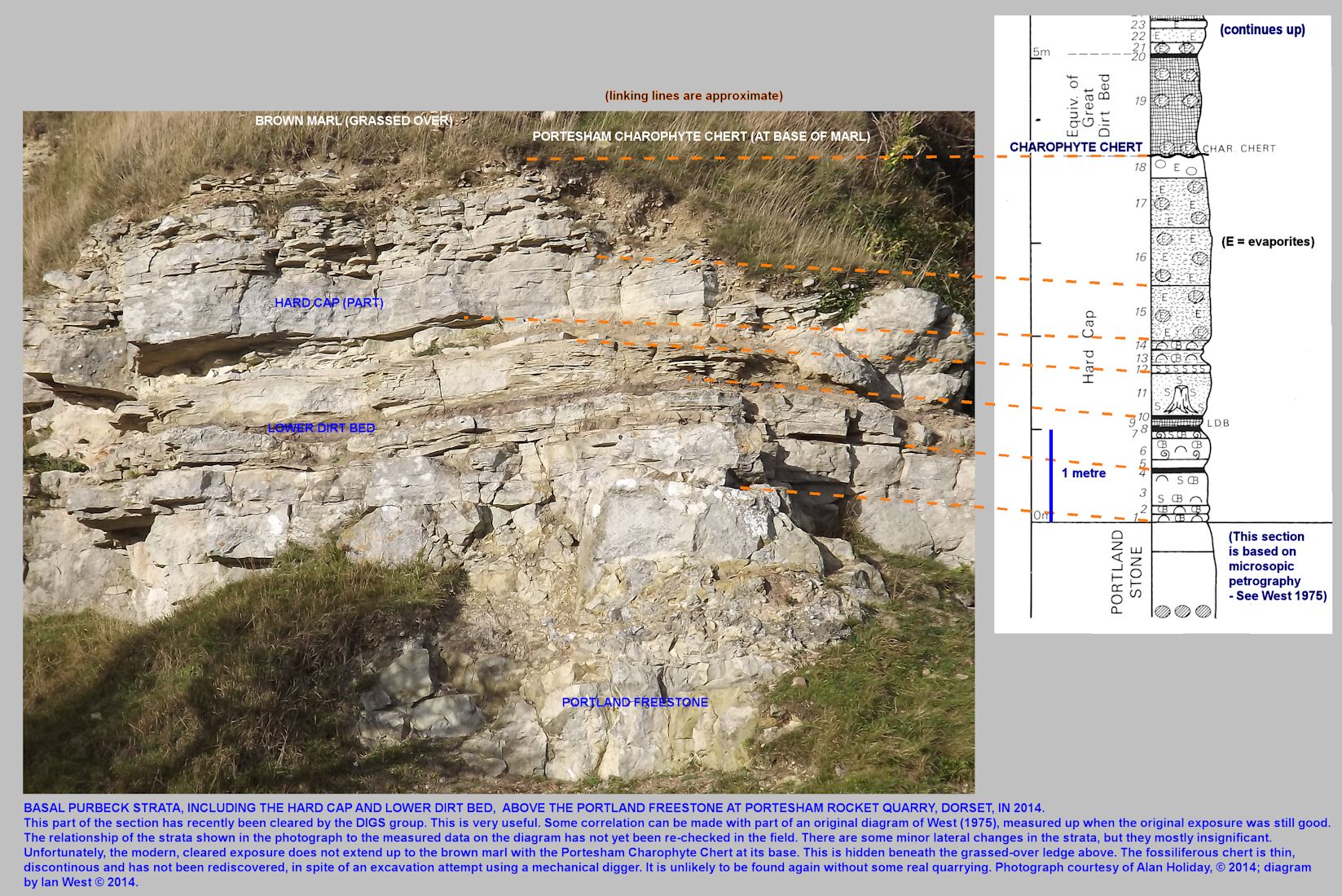
.


.

.
The Portesham Charophyte with its unusual Purbeck fauna and flora occurs at the base of a brown marl laterally corresponding to the Great Dirt Bed, the well-known Purbeck palaeosol. The brown marl is a lacustrine marl and not a soil and it contains numerous moulds of ostracods and black carbonaceous objects. It is at the base of this marl that the Portesham Charophyte Chert occurs, in patches. This chert contains broken remains of charophytes (charales), ostracods, gastropods, seeds and other plant remains. The most notable ostracod is "freshwater" (probably oligohaline) Cypridea dunkeri papulata or Ulwellia papulata as it was once known. Interesting features of this bed include the occurrence of late Jurassic horsetails and of Araucaria remains.
.
Note that in December 2014 the brown marl was found to be largely grassed over, but small parts could be exposed. The Portesham Charophyte Chert was not seen, and could not be seen without major excavation. The locality is on private land belonging to Portesham Farm (just upslope from the quarry). No excavation could take place without permission. The DIGS group provides geological information on the quarry and keeps some rock faces clear of vegetation.

PORTESHAM CHAROPHYTE CHERT
Petrography

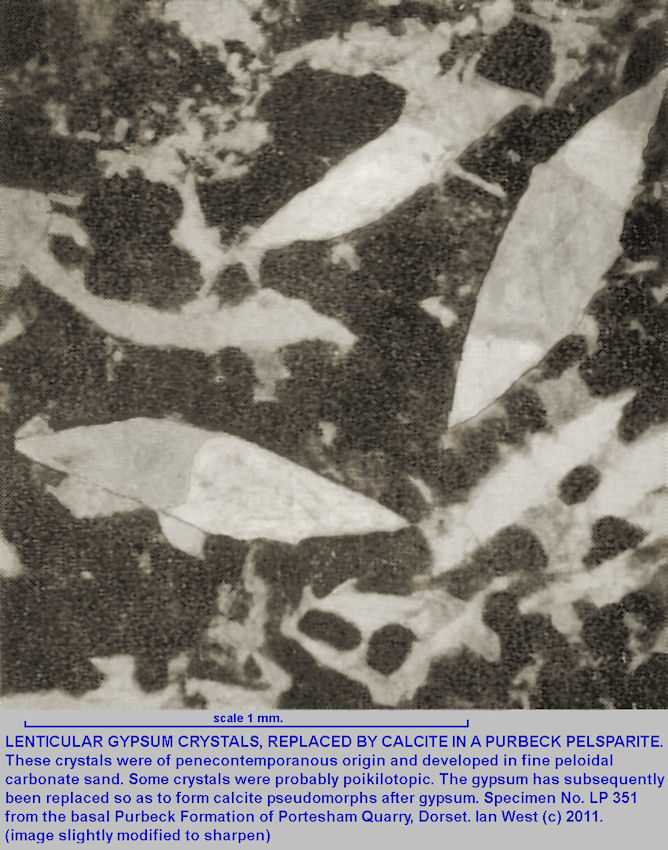

OSTRACOD FAUNAS:
Portesham Ostracods

The conspicuous, beaked ostracod, Cypridea dunkeri papulata, shown above, was originally described by F. W. Anderson (1941) in a paper on the Ostracoda of the Portland and Purbeck Beds of Swindon. Here is his original description of it as Ulwellia papulata.
"Genus ULWELLIA Anderson, 1938
Ulwellia papulata sp. nov.
Description: Carapace ovoid-triangular, tending to semicircular. Slight smooth swellings on all margins, but especially dorsally and ventrally, stronger in right valve than left.
Surface glossy; puctate or reticulate, covered with numerous small spine. Postero-ventral fringe well developed. Shell moderately thick. Ventral angle acute. A smooth border to valves which is perforated by minute thread-like pores.
Holotype: No. 70357. Complete carapace.
Dimensions No. 70357. Length, 1.04 mm.; depth, 0.66m.; width, 0.41 mm.
Horizon and locality: No. 70357. Upper Pebbly Beds [TGA 5], Town Gardens Quarry, Swindon."
[continues with discussion of a smaller and coarser variety which is common in som of the Middle Purbeck beds exposed by the old Poxwell road-cutting (not the quarry) in Dorset, and may be referred to as var. poxwellensis. See Anderson's paper for details.]

THROMBOLITES - "STROMATOLITES"
The large cylindrical thrombolite


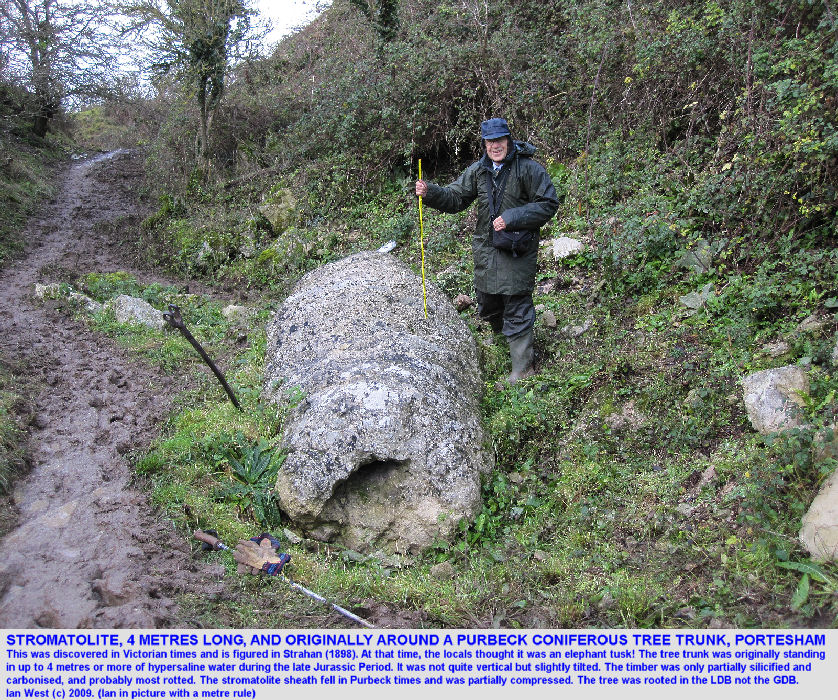

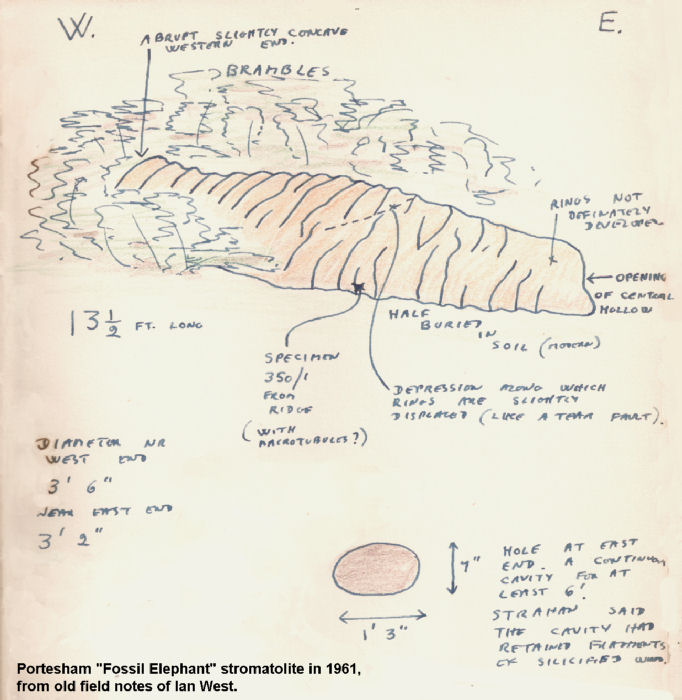
Thrombolitic [i.e. "stromatolitic" but not laminated] limestone occurs around a mould of a coniferous tree. There is no doubt that this was a tree because Strahan (1898) has recorded silicified wood within it, and traces are still present. In addition a silicified trunk has been found nearby at the time of quarrying. Silicified trunks and moulds occur commonly on the Isle of Portland and at the Fossil Forest Lulworth, although they are best developed there above the Great Dirt Bed, and not so well-developed at the Lower Dirt Bed level.
The thrombolitic coating is thickened in a series of encircling rings occurring at intervals of about 15 cm. The regularity and orientation of these suggests that the tree was standing vertically in water at the time of their formation. A depth of about 4�6 m. is implied by the length of the algal sheath.
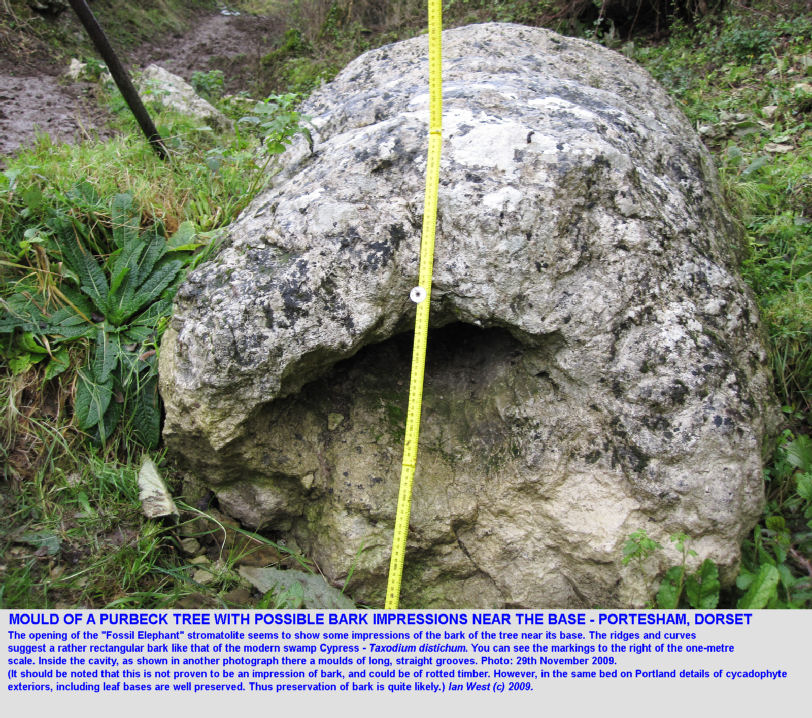
The basal part of the now-missing fossil tree has left an impression in the thrombolitic limestone. This could be just an impression or rotted timber, but it appears more likely that it is the mould of part of the bark of the tree. If this was a bark mould, then the bark seems to resemble the bark of a swamp Cypress tree, like the modern Taxodium distichum.
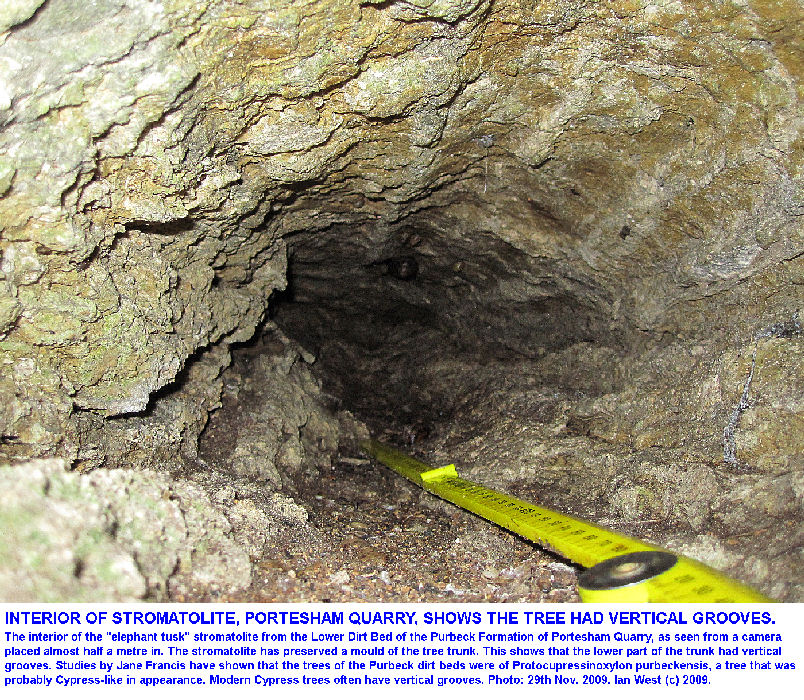
Further in the interior of the mould can be examined. This is shown in the photograph above. It can be seen that the tree trunk had well-defined straight grooves (the twisting of the trunk as shown on some reconstructions of Purbeck trees is just artistic licence by the artist). Straight grooves are common on various modern trees, including Cypress trees. Purbeck fossil trees have been described as Cupressinoxlyon ("proto - Cypress wood") by Professor Jane Francis. It is not known whether this particular tree was of Cupressinoxylon type. Araucaria-type debris is known from the Portesham Charophyte chert a little higher in the succession, and it seems likely that both Cypress-type and Araucaria-type trees were present in Purbeck environments. Whether anything resembling the Swamp Cypress existed there is not known. There was a swamp with horsetails (remains in the Portesham Charophyte Chert), and there was a freshwater lake at times. There are still so much unknown about Purbeck environments.

Purbeck Palaeogeography


Lime Kilns

Old lime kilns in Portesham Quarry are being examined and preserved by the DIGS Group (Dorset Important Geological Sites). Photographs are provided but they are not considered in detail here.

Land Plants from the Portesham Charophyte Chert
The following notes and summarised data are based largely on the valuable work of Barker el al. (1975) and published in Paleontology, vol. 18, Part 2, pp. 419-436. Dennis Barker (ostracodologist) was at that time at Middlesex Polytechnic at Enfield. The Charales were described by J. Costin at Reading University. Barker described the ostracods while at Leicester University, under the supervision of Professor Sylvester Bradley, and photographed specimens at the British Museum (now Natural History Museum). The land plants were described by C.E. Brown and S.C. Bugg of Reading University during 1961-1962, supervised by Professor T. M. Harris, the well-known palaeobotanist.
The land plants were only found at the level of the Portesham Charophyte Chert. This is the lateral equivalent of the base of the Great Dirt Bed, a well-known palaeosol, that is exposed at the Fossil Forest, Lulworth, and at the Isle of Portland and some other localities in the Weymouth area. It is a feature of the northwestern margin of the Purbeck basin. It characterises this marginal facies but does not occur in the main basin to the east (which extends to the Weald area). There the thickness of the Purbeck succession is about twice as great. The basin facies can be seen onshore in the type section at Durlston Bay, Swanage, where there is no Great Dirt Bed and no Fossil Forest at the base of the Purbecks. The boundary to the southeast between the marginal facies with well-developed palaeosols and the thicker lagoonal facies generally (but not entirely) without them is at Worbarrow Tout. [This, at least, is how it appears in the coast sections, but actually, the matter is more complicated because the type-section at Durlston Bay is south of a basin margin where there is no exposure].
The land plant remains from the Portesham Charophyte Chert were small and silicified. They were easily extracted with hydrochloric acid. There were some pieces of fusinised wood or fossil charcoal. This is not surprising since Francis has described the effects of fire on the Purbeck fossil forests. The seeds and other plant organs were rare and the authors only found fewer than one per kilogram. The fossils were uncompressed and white in colour, apart from the fusain
(Barker et al., 1975). Some of the fossil plant remains were thin-sectioned.
Go to the original paper for systematic descriptions and information. Only some brief listing and some summarised data is given here, and this webpage is only informal.
.
Horsetails - Equisetales
Equisetum mobergii (Halle ex. Moller).
There were three small specimens with narrow stems. This species was already known in the Upper Jurassic, and possibly Wealden. So there were horsetail swamps in freshwater in the area, although these do not seem to have been common features of the basal Purbeck or basal Lulworth Formation strata.
.
Conifer Tree Foliage - Brachyphyllum sp.
This is an extinct species of plant belong to the Araucariacea. They have appressed, scale-like, relatively short and broad leaves. Modern relatives are the Norfolk Island Pine and the Monkey Puzzle Tree. The Portesham specimen is just a small piece (figured in the paper) but it has leaves that are borne spirally. The leaves are longitudinally ridged but there is no median keel. Similar twigs occur in the Corallian of France. See the paper for more details and a small picture.
.
The Fossil Araucarites Cones (and modern comparisons)
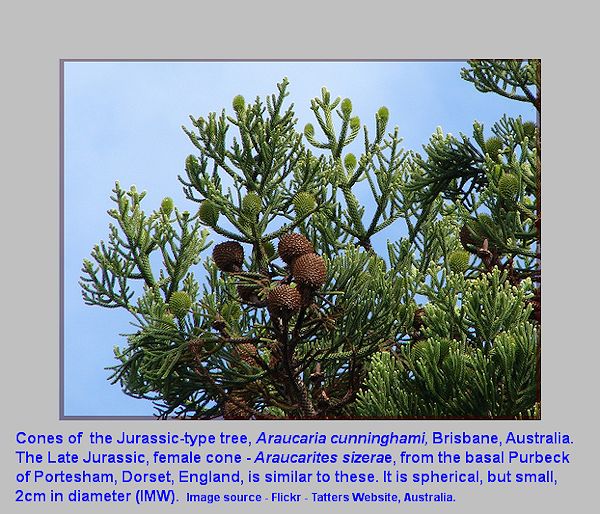
Two fragments of a cone, Araucarites sizerae, were found in the Portesham Charophyte Chert material. The cone was similar, but not identical, to that of a modern Araucaria (such as the Norfolk Island Pine, Monkey Puzzle Tree etc). The fossil seeds referred to below, and, not surprisingly, more numerous are derived from from such female cones. Later,
Francis (1983) reported male cones of Classostrobus associated with Classopolis pollen and with Cupressinocladus foliage in the Great Dirt Bed at Godnor, Isle of Portland. This is exactly the same horizon within the basal Purbeck Group as the Portesham Charophyte Chert, north of Weymouth. In addition to the cones in the basal Purbeck strata of Portland and Portesham cones also occur at what seems to be the equivalent horizon in the Vale of Wardour. So cones are present at at least three localities in the Dorset-Wiltshire area, all in relative proximity to silicified remains of the Purbeck coniferous trees (of these three, though, Portesham has hollow tree moulds and the silicified tree trunks are further east, as at Chalbury Camp).
.
The Seeds

ACKNOWLEDGEMENTS
I am much appreciative of help from many people at Portesham quarry over the last half century. In the early 1960s the late Professor Sylvester Bradley helped me with excavating fossil material. Denis Barker examined ostracods from this quarry and worked with other specialists at Reading University. Dr. Roy Clements of Leicester University has studied the gastropod fauna from the Purbecks of this quarry. Valerie Bristol helped me with field work and recorded details of the quarry in the 1960s. In more recent times, Dr. Mike Cosgrove cleared part of the quarry with a JCB digger and manual work by volunteers as part of a DIGS project in 1995. I am very grateful to Alan Holiday and Jeremy Cranmer and the Open University Geological Society and the DIGS Group who in 2009 cleared more of the old quarry, especially the upper part with "Cypris" Freestones. Further clearance took place in 2014. I much appreciate being able to use photographs taken by Alan Holiday. This old quarry has survived as an exposure largely because of re-excavation and re-exposure and the removal of vegetation.

REFERENCES AND BIBLIOGRAPHY
See also:
Purbeck Formation - Bibliography |
.
Anderson
, F.W. 1941. Ostracoda from the Portland and Purbeck Beds at Swindon. Proceedings of the Geologists' Association, vol. 51, pp. 373-384 plus two plates. This paper follows that of Professor Peter Sylvester Bradley on the Purbeck Beds of Swindon.
Anderson, F.W. 1958. In: Wilson, V., Welch, F. B. A., Robbie, J.A. and Green, G.W. 1958. Geology of the Country around Bridport and Yeovil. Memoir of the Geological Survey of Great Britain, Explanation of sheets 327 and 312. 118-129. Purbeck ostracod zones given for the Purbeck outcrops in the east of the area.
.
Arkell
, W.J. 1941. The gastropods of the Purbeck Beds. Quarterly Journal of the Geological Society, London , vol. 97, part 1, 79-128. [Example extract - the start - follows:]
Isolated occurrences of genera such as Viviparus and Valvata are known in Bathonian, Liassic and more doubtfully even earlier rocks, but the earliest assemblage of a dozen genera of unequivocally freshwater molluscs is found in the wonderful fauna of the Purbeck Beds. Attention was first called to it by Thomas Webster (1816, pp. 191-2) (see below, p. 81). His remark, "It is rather surprising that this very ancient freshwater formation should not have excited more attention," might almost be said to be still true; for since J. de C. Sowerby figured a couple of species of Viviparus from the Purbeck Beds in 1826 and six species of lamellibranchs in that year and in 1836 (in Fitton's memoir), no further Purbeckian mollusca have been adequately figured in this country or described in the English language.
Edward Forbes was preparing a monograph on the invertebrate fauna of the Purbeck Beds when his work was cut short in 1854 by his death at the age of 39. All that appeared was a preliminary account, in which the genera Viviparus, Valvata. Lymnaea, Planorbis, Hydrobia, Physa, Melania, Cyclas, and
Unio were recorded, and also many marine genera, but no species were mentioned. A number of MS. names were introduced by him on labels and in the Survey catalogues, and some of them have been used by other authors, but if any manuscript or type specimens existed they have disappeared.
In 1856 Osmund Fisher published a detailed account of the stratigraphy of the Dorset Purbeck Beds, recording all the genera mentioned by Forbes and assigning them to their precise horizons. H. W. Bristow also noted many of them in his vertical sections of the Geological Survey, sheet 22 (1857). A useful reprint of the Durlston section with the beds numbered was published by Damon (1884, pp. 201-209).... [continues with systematic descriptions from page 83 onwards].
Arkell
, W.J. 1947. The Geology of the Country around Weymouth, Swanage, Corfe and Lulworth. Memoir of the Geological Survey Great Britain. 386pp. With Wright, C.W.and Melville, R.V. 2nd edition - 1952 with Addenda and Corrigenda.
.
Barker
, D., Brown, C.E., Bugg, S.C. and Costin, J. 1975. Ostracods, land plants and charales of the basal Purbeck Beds of Portesham Quarry. Palaeontology, 18, 419-436.
A thin cherty layer near the base of the Purbeck Beds in Dorset has yielded a flora of land plants (including stems of Equisetum mobergii, isolated seeds referred to Carpolithes rubeola, C. glans, C. rhabdotus, C. cocos, C. gibbus, C. acinus and C. westi spp. nov., and cones of Araucarites sizerae sp. nov.) and freshwater Charales (Clavator westi sp. nov.) as well as freshwater ostracods. The discovery of Clavator westi in Lower Purbeck deposits opens up the possibility of separating the Lower Purbeck from the Middle Purbeck using the Charales. Among the ostracods Cypridea dunkeri Jones is shown to have stratigraphic value. Correlation of these basal Purbeck Beds in Dorset with the Swindon Series further north indicates that at Swindon either Purbeck conditions were established earlier than in Dorset, or that Portland conditions recurred later.
.
Bielecka
, W. 1975. Foraminifera and Brackish Ostracoda from the Portlandian of Polish Lowlands. Paperback book by Wanda Bielecka (Author).
FORAMINIFERA AND BRACKISH OSTRACODA FROM THE
PORTLANDIAN OF POLISH LOWLANDS
Contents
Page
Abstract 296
Introduction 296
Characteristic of the Polish Lowlands Portlandian and its microfauna 298
Microfaunal zonation of the Portlandian of the Polish Lowlands 301
Comparison of the Uppermost Jurassic foraminiferal assemblages of the Polish
Lowlands and Europe 303
Systematic Part
Foraminiferida
Family Lituolidae de Blainville, 1825 .
Genus Haplophragmoides Cushman, 1910
Genus Everticyclammina Redmond, 1964
Genus Ammobaculites Cushman, 1910
Genus Haplophragmium Reuss, 1860 .
Genus Triplasia Reuss, 1854
Family Ataxophragmiidae Schwager, 1877
Genus Belorussiella Akimets, 1958
Family Nubeculariidae Jones, 1875 .
Genus Nubecularia Defrance, 1825
Family Miliolidae Ehrenberg, 1835 .
Genus� Palaeomiliolina Loeblich & Tappan, 1964 .
Family Nodosariidae Ehrenberg, 1838
Genus Nodosaria Lamarck, 1812
Cenus Citharina d'Orbigny, 1839 .
Genus Citharinella Marie, 1938
Genus Frondicularia Defrance, 1826
Genus Geinitzinita Sellier de Civrieux Dessauvagie,
Genus Lagena Walker & Jacob, 1798 .
Genus Lenticulina Lamarck, 1804 .
Genus Marginulina d'Orbigny, 1826 .
Genus Marginulinopsis Silvestri, 1904
Genus Planularia Defrance, 1826 .
Genus Pseudonodosaria Boomgaart, 1949 . 346
Genus Saracenaria Defrance, 1824 349
Genus VaginuZinopsis Silvestri, 1904 . 350
Family Polymorphinidae d'Orbigny, 1839 352
Genus Eoguttuzina Cushman & Ozawa, 1930 352
Genus Guttuzina d'Orbigny, 1839 353
Genus Tristix Macfadyen, 1941 354
Family Spirillinidae Reuss, 1862 357
Genus SpiriZZina Ehrenberg, 1843 357
Family Involutinidae Biitscheli, 1880 357
Genus TrochoZina Paalzow, 1922 . 357
Family Ceratobuliminidae Cushman, 19~7 359
Genus PseudoZamarckina Mjatliuk, 1959 359
Genus Epistomina Terquem, 1883 361
Ostracoda'
Family Cyprididae Baird, 1845 . 362
Genus Mantelliana Anderson, 1966 362
Family Ilyocyprididae Kaufmann, 1900 363
Genus Rhinocypris Anderson, 1940 363
Genus Damonella Anderson, 1966 363
Genus Cypridea Bosquet, 1852 . 364
Family uncertain 368
Genus Scabriculocypris Anderson, 1940 368
Family Darwinulidae Brady & Norman, 1889 368
Genus Darwinula Brady & Robertson, 1885 368
Family Cytheridae Baird, 1850 . 370
Genus Fabanella Martin, 1961 . 370
Family Limnocytheridae Klie, 1938 371
Genus Theriosynoecum Branson, 1933 371
Family Cytherideidae Sars, 1925 . 371
Genus Dicrorygma Poag, 1962 . 371
Family Cytheruridae Milller, 1894 372
Genus Orthonotacythere Alexander, 1933 372
Genus Procytheropteron Ljubimova, 1955 373
Family Progonocytheridae Sylvester-Bradley, 1948 373
Genus Klieana Martin, 1940 373
References 375
Abstract: Foraminifera of the Lower and Middle Portlandian and Ostracods of the
Purbeckian facies of the Upper Portlandian of Polish Lowlands were studied; 63 foraminiferal
species (including 12 new) and 21 ostracod species (including one new, Cypridea praealta sp.n.) are described. Analysis of stratigraphic ranges of the microfauna made it possible to distinguish 5 foraminiferal zones (I-V) of the Lower and
Middle Portlandian and 5 ostracod zones (F-B) of the Purbeckian facies of the Upper Portlandian.
The foraminiferal microfauna of the Portlandian of Poland appears most similar to those from the Lower and Middle Volgian of the Russian Platform.
INTRODUCTION
Up to now, the foraminifers of upper part of the Upper Jurassic developed in epicontinental facies in western Europe were only occasionally studied by Guyader (1968), Groiss (1963, 1967 a, b, 1970), Hanzlikova (1965),
PORTLANDIAN FORAMINIFERA AND OSTRACODA 297
Lloyd (1959) and others. The Upper Jurassic foraminifers from Poland were the subject of studies of Bielecka & Pozaryski (1954), Bielecka (1960)
and Garbowska (1970). Much more attention has been paid to the foraminifers of the Lower and Middle Volgian of the USSR (Furssenko & Polenova,
1950; Dain, 1934, 1972; Dain & Kusnetzova, 1971; Ivanova, 1971; 1973; Kuznetzova, 1963, 1965, 1969; Mjatliu~, 1939, 1959; and others). The
studies dealing with brackish ostracods of Poland (Bielecka & Sztejn, 1966; Marek, Bielecka & Sztejn, 1969) are of regional-stratigraphic character.
The paper presents results of palaeontological and stratigraphic studies on foraminifers of the Lower and Middle Portlandian and brackish ostracods
of the Purbeckian facies of the Upper Portlandian (where foraminifers do not occur) of the Polish Lowlands. The analysis of the microfauna
was based on core material from boreholes drilled by the Geological Institute (Warsaw) and oil industry in years 1948-1972. The core material was derived from the areas of Kujawy swell, Warsaw basin, Baltic
syneclize, L6dz and Mogilno basins and Pomerania (NW part of Pomeranian swell, Pomeranian basin and N part of Szczecin basin) (see Text-fig. 1). The ammonite zonal scheme of the Lower and Middle Portlandian
(Table IV), proposed by Dembo~ska (1973), and ostracod zonal scheme of the Upper Portlandian develdped in the Purbeckian facies, proposed by Bielecka & Sztejn (1966), are accepted here. Over 40 borehole profiles (Text-fig. 1) with full or almost full coring
were selected out of about 100 borehole profiles covered by the microfauna studies. The profiles selected yield more or less numerous microfaunal
assemblages characteristic of a given part of Poland. Several foraminiferal species of the uppermost stage of the Jurassic, including some previously described by Bielecka & Pozaryski (1954) from Upper Jurassic
strata of Central Poland, are revised. On the whole, 63 foraminiferal species (including 12 species and 2 subspecies new) and 21 ostracod species
(including 1 new) are described (see Tables I-II). The palaeontological material is housed in the Geological Institute, Warsaw (abbr. IG). The species listed in Table III are not recorded in all parts of the Polish
Lowlands. In particular parts a few species are missing. This primarily results from lithofacies differences and location of a given area in relation
to the center of the basin. The microfaunaI assemblages are the richest in the center, becoming impoverished towards the periphery of the basin.
[continues]
.
Coram,
R. 2009. Purbeck Fossil Insects; Weymouth Relief Road, Bincombe. 10 pp. pdf file, May 2009 by Dr. Robert Coram. Extract: "In May 2009 excavations for the Weymouth Relief Road at Bincombe exposed a
Purbeck section displaying both of Fisher�s insect beds. Along with Ed and Biddy Jarzembowski, I had the opportunity to visit the site and collect insect specimens. The upper of Fisher�s beds yielded a small amount of material; his Lower Insect Bed, near the base of the Purbeck, proved much more productive. A selection of specimens from this horizon are shown on the next few pages, followed by comments on the likely palaeoenvironment."
[Remains of Trichoptera (Caddis Flies), Neuroptera (Lacewings), Coleoptera (Beetles), Orthoptera (Grasshopers and Crickets), Odonata (Dragonflies and Damselflies), Hemiptera (Bugs), Diptera (True Flies), Blattodia (Cockroaches) and Mecoptera (Scorpion Flies) have recorded by Robert Coram and many are illustrated in photographs.]
.
Damon, R. 1884. Geology of Weymouth, Portland, and Coast of Dorsetshire, from Swanage to Bridport-on-the-Sea: with Natural History and Archaeological Notes. New and Enlarged Edition (2nd Ed.), Weymouth, R.F. Damon, London, Edward Stanford. 250p. With a colour geological map of part of the Dorset coast, and including a log of the Purbeck strata of Durlston Bay, Swanage, by H. W. Bristow and Prof. E. Forbes (although note that it contains a small error).
.
Feist
, M., Lake, R.D. and Wood, C.J. 1995. Charophyte biostratigraphy of the Purbeck and Wealden of southern England. Palaeontology, 38, Part 2, 407-442. Abstract: The distribution of charophyte assemblages in the Purbeck and Wealden sequence of southern England has been established from borehole samples from the Weald and from outcrop material collected in Dorset, Wiltshire and the Isle of Wight. Of the twenty-one taxa represented, three are new: Globator rectispirale, Clypeator britannicus and Sphaerochara andersonii; three new combinations are proposed: Globator praecursor, Globator protoincrassatus and Atopochara triquetra. The Chinese Valanginian species Flabellochara xiangyunensis is recognised for the first time in Europe. In the context of the phylogeny of the Family Clavatoraceae, G. rectispirale represents the Jurassic ancestor of the Globatorlineage and a separate origin is suggested for both Flabellochara and Clypeator. The correlation established with the Tethyan realm locate the Jurassic Cretaceous boundary within the Lulworth Formation of the Purbeck Group; in this context, the whole 'Purbeck' sequence of Swindon (Wiltshire) is attributed to the Upper Tithonian. The distribution of the Clavatoraceae indirectly confirms the contemporaneity of the Boreal Galbanites kerberus and Titanites anguiformis with the Tethyan 'Durangites' ammonite zones. For the Wealden Supergroup, the charophyte data affirm the Hauterivian-Barremian boundary near the upper division of the Weald Clay and the Upper Barremian is identified at the base of the Vectis Formation of the Isle of Wight.
.
Fisher
, O. 1856. On the Purbeck strata of Dorsetshire. Transactions of the Cambridge Philosophic Society, 9, 555-581. [Classic early log of the Durlston section with useful faunal information. See Wilding, 1988 for biography of Osmond Fisher]
.
Francis, J. Papers by Dr. Jane Francis of Leeds University, the Purbeck tree and soil specialist. (She completed her Ph.D. thesis on the Purbeck Formation at Southampton University and supervised by IMW).
Francis
, J. E. 1983. The Fossil Forests of the Basal Purbeck Formation (Upper Jurassic) of Dorset, Southern England. Unpublished Ph.D. Thesis, University of Southampton.
Francis, J. E. 1986 The Calcareous Paleosols of the Basal Purbeck Formation (Upper Jurassic) Southern England. p. 112-138 in: V.P. Wright, (Ed.) Paleosols: Their recognition and interpretation. Blackwell, Oxford. (Basal Purbeck Dirt Beds of Lulworth and Portland)
Francis, J.E. 1983. The Dominant Conifer of the Jurassic Purbeck Formation, England. Palaeontology, 26, 277-294. [Key paper. Protocupressinoxylon purbeckensis a cypress or juniper-like tree. Cycadophytes also occurred but were much less common.]
.
Horne
, D.J. 1988. Cretaceous ostracoda of the Weald. British Micropalaeontological Society Field Guide, 4, 42pp.
Horne, D.J. 1995. A revised ostracod biostratigraphy for the Purbeck-Wealden of England. Cretaceous Research, 16, 639-663, Academic Press Ltd. By David J. Horne. Department of Earth and Environmental Science, University of Greenwich, Chatham Maritime, Kent, ME4 4TB.
Abstract: The extensive work of the late F.W.Anderson on Purbeck-Wealden ostracods is critically reviewed. He used ostracods as the basis of four different kinds of stratigraphical subdivision in the English Purbeck-Wealden sequence: zones (based on the ranges of Cypridea species), faunicycles (based on alternations of assemblages dominated by Cypridea with assemblages dominated by other genera), 'beds' and 'assemblages' (both groupings of faunicycles). It is concluded that although Anderson's own correlations using these schemes might be regarded as reliable, all of them were so poorly defined as to preclude their use by future workers. Furthermore, erroneous zonation schemes have been propagated by other authors who mistook Anderson's assemblages for zones. In spite of criticisms of his applications and interpretations of ostracods, Anderson's data remain the best available for the Purbeck-Wealden of the Weald and Wessex sub-basins. As a solution to some of these problems, a new ostracod biozonation scheme is proposed, comprising three zones (Theriosynoecum forbesi Zone, approximately equal to the Purbeck; Theriosynoecum alleni Zone, approximately equal to the Hastings Beds Group; Theriosynoecum fittoni Zone, approximately equal to the Weald Clay Group), subdivided into eight subzones on the basis of the ranges of Cypridea species. [end of abstract]
.
Howitt
, F. 1964. Stratigraphy and structure of the Purbeck inliers of Sussex (England). Quarterly Journal of the Geological Society, London, 120, 77-113. By Frank Howitt. Published 18th February 1964. With maps and a discussion.
Abstract: The Purbeck Beds exposed in Sussex are redescribed together with new sections exposed in gypsum mine workings and boreholes. Comparisons are made with Purbeck Beds elsewhere in southern England in boreholes and at outcrop. A new map of the the Purbeck inliers is presented and the structure is discussed. Conditions of sedimentation are illustrated by isopachyte maps.
Contents:
1. Introduction
2. Historical Review
3. Stratigraphy
(a) General
(b) Sussex type area
(c) Comparison of the Sussex Purbeck type-sections with the remainder of the Sussex inliers
4. Structure
5. Conditions of sedimentation
6. Appendix: Purbeck Beds in boreholes and outcrops of southern England.
7. References
Plates 3-4, Geological Map and Structural Map - Central Weald.
.
Pugh
, M.E. 1966. The Petrography of the Lower Purbeck Limestones of Dorset. Unpublished M.Sc. Thesis, Chelsea College, London.
Pugh, M.E. 1968. Algae from the Lower Purbeck limestones of Dorset. Proceedings of the Geologists' Association, London, 79, 513-523.
.
Strahan
, A. 1898. The Geology of the Isle of Purbeck and Weymouth. Memoirs of the Geological Survey. Her Majesty's Stationery Office, London. 278 pages with a map.
.
Underhill
, J.R. 2002. Evidence for structural controls on the deposition of the late Jurassic- early Cretaceous Purbeck Limestone Group, Dorset, southern England. Pp. 21-40 in: Milner, A.R. and Batten, D.J. (Editors) 2002. Life and environments in Purbeck times. Special Papers in Palaeontology, No. 68, Palaeontological Association, London, 268pp. Abstract: Integration of field studies with subsurface data demonstrate that deposition of the late Jurassic - early Cretaceous Purbeck Limestone Group occurred under semi-arid conditions during an important phase of syntectonic extensional activity in the Wessex Basin. Use of structural restorations and neotectonic analogue studies support the introduction of a new model to account for the regional and local along-strike variability in deposition of the Purbeck Limestone Group. It is proposed that the segmented nature of the episodically-active, basin-bounding Purbeck Fault explains observed thickness and sedimentological variations, including lateral facies changes and clast reworking. In addition to affording a tectonic framework in which to understand the rich palaeontological assemblages, the new depositional model also provides a mechanism for explaining the rapid death and unusual preservation of conifer forests through rapid submergence following co-seismic activity on the normal fault system. [By John R. Underhill, Department of Geology and Geophysics, University of Edinburgh.]
Underhill
, J.R. and Stoneley, R. 1998. Introduction to the development, evolution and petroleum geology of the Wessex Basin. In: Underhill, J.R. (Ed.) Development, Evolution and Petroleum Geology of the Wessex Basin. Geological Society, London, Special Publications, 133, 1-18.
.
West
, I.M. 1961. Lower Purbeck Beds of Swindon facies in Dorset. Nature, London, 190, 526. Extract: ' .. a marl has been discovered with a fauna resembling that of the freshwater facies of the 'Swindon Series'. In the well-known Portisham [or Portesham] quarry with the 'fossil elephant' [stromatolitic limestone around a tree trunk], the tree-foot "impure marls with seams of chert" listed by Woodward as occurring 9 feet, 6 inches above the Portland Stone have been found to contain the Swindon ostracod Ulwellia papulata Anderson, and well-preserved charophytes in abundance. Gastropods are also abundant and perhaps have Swindon affinities... continues. [The fauna and flora discovered in the Portesham Charophyte Chert was subsequently described by Barker, D., Brown, C.E., Bugg, S.C. and Costin, J. 1975. Ostracods, land plants and charales of the basal Purbeck Beds of Portesham Quarry. Palaeontology, 18, 419-436.]
West, I.M. 1964a. Evaporite diagenesis in the Lower Purbeck Beds of Dorset. Proceedings of Yorkshire Geological Society, 34, 315-330. [Petrographic evidence of vanished evaporites in the Caps and Broken Beds - pseudomorphs, celestite, lutecite etc. Diagenetic history established.] Abstract: Five stages have been determined in the diagenetic history of the calcium sulphate beds of Lower Purbeck age in Dorset, particularly by reference to abundant pseudomorphs and other relict textures and structures preserved in late-formed gypsum and in secondary silica and calcite. The weight of the overburden is thought to have controlled the changes. Occurrences are described of minerals, including celestite, calciostrontianite, lutecite and quartz remaining after the removal in solution of gypsum. A description is also given of secondary limestones which occur particularly in the Caps and Broken Beds. They are shown to be almost entirely replacements of original sulphate deposits. [End of abstract].
West, I.M. 1975. Evaporites and associated sediments of the basal Purbeck Formation (Upper Jurassic) of Dorset. Proceedings of the Geologists' Association, London, 86, 205-225. Abstract: Four facies of limestones, each with particular contents of calcitised evaporites and of skeletal debris were recognised. They are compared with sediments of modern evaporite-depositing environments. The lowermost limestones, stromatolitic and pelletoid with foraminifera, probably originated in intertidal to shallow subtidal, moderately hypersaline, water. Overlying pelletoid limestones with algal-mats and some gypsum are products of high-intertidal flats. The main evaporite beds were originally gypsum, probably formed in supratidal to intertidal, very hypersaline, palaeoenvironments. The gypsum was converted to anhydrite and later brecciated in part, forming the Broken Beds. Extensive calcitisation produced porous unfossiliferous limestones. Ostracodal limestones above probably originated in shallow, only moderately hypersaline water. All the basal Purbeck strata were formed in and around a large shallow gulf with extensive tidal flats and with water of varying but predominantly high salinities. At times of uplift, thin soils developed on the former margins of the gulf. Forests were able to exist there because, although the area was within the semi-arid zone, it was probably very near to the boundary of the warm-temperate zone. End of Abstract.
[This paper deals specifically with the Portesham section - see p. 216 and p. 220.]
West, I.M. 1979. Sedimentary Environments and Diagenesis of Purbeck Strata (Upper Jurassic - Lower Cretaceous) of Dorset, U.K. Unpublished Ph.D. Thesis, Southampton University, 181 p.
West, I.M., 1979. Review of evaporite diagenesis in the Purbeck Formation of southern England. In: Symposium "Sedimentation Jurassique W. Europeen." A.S.F. Publication Speciale, No.1, March, 1979. 407-416.
.
Wilson
, V., Welch, F. B. A., Robbie, J. A. and Green, G.W. 1958. Geology of the Country around Bridport and Yeovil. Memoir of the Geological Survey of Great Britain, Explanation of sheets 327 and 312. 118-129. With contributions on: The Purbeck Beds by F.W. Anderson, D.Sc.; Palaeontology by R.V. Melville, M.Sc.; and Ground Water by S. Buchan, B.Sc., Ph.D.
[See particularly pp. 118 et seq - Purbeck Beds [by F.W. Anderson. Purbeck ostracod zones of that date are given with thicknesses of lithological subdivisions.].
.
Woodward
, H.B.1895. The Jurassic Rocks of Britain. Vol 5. The Middle and Upper Oolitic Rocks of England (Yorkshire excepted). Memoirs of the Geological Survey of the United Kingdom. 499pp. [See pages 254-255 on the Purbeck strata of Worbarrow Tout.]
.
Westwood
, J.O. 1854. Contributions to fossil entomology. Proceedings of the Geological Society, in: Quarterly Journal of the Geological Society, 1854, vol. 10, issue 1-2, pp. 378-396.
By J. O. Westwood, F.L.S. etc. Available online from the
Lyell Collection, Geological Society of London.
The microscopical examination which I have been compelled to make of so many hundreds of fossil insect-remains, for the most part in a fragmentary condition, from the Lower Purbecks of Dorset, although beyond measure tedious from the unsatisfactory results afforded by the nature of the specimens, has still enabled me to arrive at some results, and to form a general comparison of these insect-deposits with those which I similarly investigated whilst preparing the plates of Mr. P. B. Brodie's work on the fossil insects of the Wiltshire Purbecks, etc. If we take into consideration the small, and even minute size of the great majority of the insects, and indeed of the whole of the Coleoptera, which have been passed under review, the idea, that we have before us the wreck of an Insect Fauna of a temperate region, is at once raised; for although it would be rash to assert that a mass of remains of the existing tropical insects might not be accumulated in which a large quantity of minute beetles and flies would not be present, yet I cannot conceive any process, either arising from currents of water, or chemical dissolution of insect matter, which would carry off or destroy the many gigantic forms of insect life always occurring in the tropics.
.
Whitaker
, W. and Edwards, W. 1926. Wells and Springs of Dorset. Memoir of the Geological Survey of England and Wales. [This includes the log of the Friar Waddon Borehole, Dorset with Purbeck strata.]
.
Williamson I.P. 2008. The distribution of Late Kimmeridgian and Portlandian ostracoda in southern England. (La repartition des ostracodes du Kimmeridgien sup�rieur au Portlandien en Angleterre meridionale). Revue de Micropaleontologie, vol. 45, Issue 3, July - September 2008, pp. 221-238. Ostracodology - Linking bio and geo sciences in the marine realm - Part 1. By Ian P. Wilkinson, British Geological Survey, Keyworth, Nottingham, NG12 5GG.
Available online from 1 October 2007.
Abstract:
The vertical distribution of ostracods in the Upper Kimmeridgian and Portlandian (sensu anglico) succession in three cored boreholes at Hartwell, Tisbury and Fairlight, are compared to other successions in southern England. The Upper Kimmeridge Clay Formation yields rich, but low diversity ostracod faunas, characterised by stratigraphically restricted species of Aaleniella, Galliaecytheridea, Klentnicella, Macrodentina, Mandelstamia, Micrommatocythere, Paralesleya and Prohutsonia. Several continue into the Portlandian, but some species, belonging to genera such as Cytherelloidea, Paracypris, Fabanella, Galliaecytheridea, Klieana, Paraschuleridea, Eocytheridea, Paranotacythere, Procytheropteron, Rectocythere and Macrodentina, appear for the first time. Biostratigraphical subdivision is made difficult by provincialism caused by decreasing salinities and facies change during the Late Portlandian. Marine taxa such as Protocythere, Macrocypris, Paraschuleridea, Paranotacythere, Procytheropteron and Rectocythere were replaced by euryhaline forms, such as species of Fabanella and Mantelliana, and fresh-oligohaline species of the genera Cypridea, Scabriculocypris, Alicenula and Rhinocypris.
Woodward
, H.B. 1895. The Jurassic Rocks of Britain. Vol 5. The Middle and Upper Oolitic Rocks of England (Yorkshire excepted).
Memoirs of the Geological Survey of the United Kingdom. 499pp.

|Home and List of Webpages
Copyright
© 2013 Ian West, Catherine West, Tonya Loades and Joanna Bentley. All rights reserved. This is a purely academic website and images and text may not be copied for publication or for use on other webpages or for any commercial activity. A reasonable number of images and some text may be used for non-commercial academic purposes, including field trip handouts, lectures, student projects, dissertations etc, providing source is acknowledged.
Disclaimer:
Geological fieldwork involves some level of risk, which can be reduced by knowledge, experience and appropriate safety precautions. Persons undertaking field work should assess the risk, as far as possible, in accordance with weather, conditions on the day and the type of persons involved. In providing field guides on the Internet no person is advised here to undertake geological field work in any way that might involve them in unreasonable risk from cliffs, ledges, rocks, sea or other causes. Not all places need be visited and the descriptions and photographs here can be used as an alternative to visiting. Individuals and leaders should take appropriate safety precautions, and in bad conditions be prepared to cancell part or all of the field trip if necessary. Permission should be sought for entry into private land and no damage should take place. Attention should be paid to weather warnings, local warnings and danger signs. No liability for death, injury, damage to, or loss of property in connection with a field trip is accepted by providing these websites of geological information. Discussion of geological and geomorphological features, coast erosion, coastal retreat, storm surges etc are given here for academic and educational purposes only. They are not intended for assessment of risk to property or to life. No liability is accepted if this website is used beyond its academic purposes in attempting to determine measures of risk to life or property.


Webpage - written and produced by:
Ian West, M.Sc. Ph.D. F.G.S.
.
at his private address, Romsey, Hampshire, kindly supported by Southampton University,and web-hosted by courtesy of iSolutions of Southampton University. The website does not necessarily represent the views of Southampton University. The website is written privately from home in Romsey, unfunded and with no staff other than the author, but generously and freely published by Southampton University. Field trips shown in photographs do not necessarily have any connection with Southampton University and may have been private or have been run by various organisations.
 .
.





